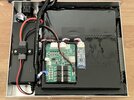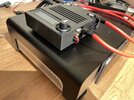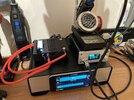I am looking for a simple way to lower the voltage of my 8.4V 7A charger. The charger I am using does not have a trim pot and I do not know which group of resistors control the output voltage. I know that diodes cause a voltage drop. Is it possible to drop between 0.4-0.6V by placing one on the output in series? The DC is constantly connected to the battery when the mains is off would a diode also stop the current draw when it is off?
 I am sorry but I literally know nothing about electronics. The diode you suggested is ok but I cannot find it in the UK. It needs to be able to withstand 3-4A continuous with 7A peaks and provide a drop of around 0.4V. I am open to any suggestions you might have.
I am sorry but I literally know nothing about electronics. The diode you suggested is ok but I cannot find it in the UK. It needs to be able to withstand 3-4A continuous with 7A peaks and provide a drop of around 0.4V. I am open to any suggestions you might have.


